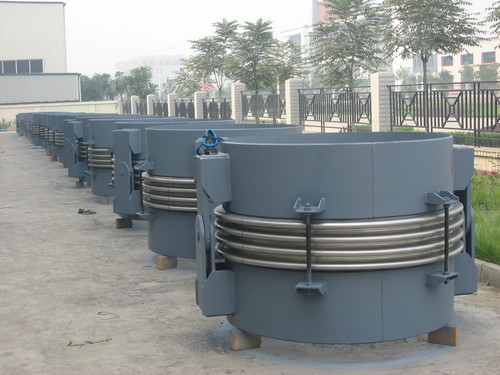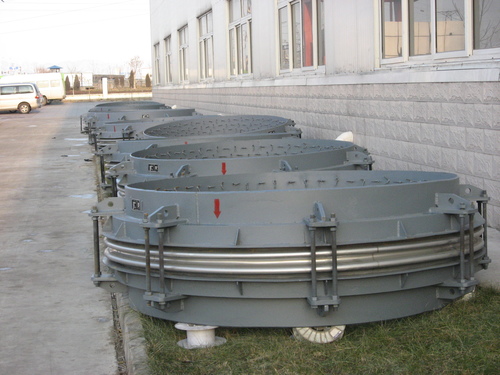Description
1. Introduction to Single Hinged Expansion Joints
The Single Hinged Expansion Joint is a specialized angular movement compensation device used in piping systems, widely applied in steelmaking, thermal power plants, and petrochemical industries. Its primary function is to absorb angular displacement in a single plane caused by thermal expansion, mechanical vibration, or equipment movement while withstanding internal pressure thrust to ensure pipeline system safety.
2. Structure and Working Principle
2.1 Key Components
- Bellows: Made of stainless steel (304/316L/321) for high-temperature and corrosion resistance.
- Hinge Mechanism: Consists of hinge plates and pins to constrain movement direction and withstand pressure thrust.
- Pipe Connections: Flanged or welded ends for pipeline integration.
- Tie Rods: Used only for transportation/installation (removed before operation).

Figure 1: Typical structure (Source: Industry data)
2.2 Operating Principle
- Angular Compensation: Allows ±4° to ±9° movement in one plane via hinge rotation.
- Pressure Thrust Resistance: Hinge design absorbs pipeline pressure loads.
- System Integration: Often used in sets of 2-3 to form “L” or “Z” shaped compensation systems.
3. Steelmaking Industry Applications
3.1 Key Use Cases
- Blast furnace gas pipelines: Compensates thermal movement between hot blast stoves and dust removal systems.
- Converter flue ducts: Accommodates tilting-induced pipe displacement.
- Continuous casting cooling lines: Mitigates thermal stress from temperature fluctuations.
- Waste heat recovery systems: Reduces thermal stress in high-temperature flue gas ducts.
3.2 Special Requirements
- High Temp Resistance: Withstands 800°C–1200°C (310S/Inconel materials recommended).
- Corrosion Resistance: Resists SO₂/H₂S (316L or anti-corrosion coatings required).
- Pressure Capacity: Designed for 0.6–2.5MPa operating pressures.
4. Technical Specifications & Selection Guide
4.1 Critical Parameters
| Parameter | Standard Range | Steelmaking Recommendation |
|---|---|---|
| Diameter (DN) | 65–3000 mm | 200–1500 mm |
| Design Pressure | 0.1–2.5 MPa | 1.0–2.5 MPa |
| Temperature | -20°C–450°C (Standard) | 200°C–1200°C (High-Temp) |
| Angular Movement | ±4°–±9° | ±6°–±9° (High-Flexibility) |
| Connection Type | Flanged/Welded | Welded (Leak Prevention) |
4.2 Selection Considerations
- Cold Springing:
- Pre-compression (50–100%) recommended for high-pressure/large-displacement scenarios.
- Installation Orientation:
- Hinge plane must align with pipeline movement direction.
- System Design:
- Requires paired or triple-unit configurations for multi-directional compensation.
5. Maintenance & Troubleshooting
5.1 Common Failures & Solutions
| Issue | Root Cause | Solution |
|---|---|---|
| Hinge Jamming | Pin corrosion/lubrication loss | Apply high-temp grease |
| Bellows Cracking | Overheating/fatigue | Upgrade material grade |
| Leakage | Seal failure/weld defects | Replace gaskets/reweld |
5.2 Maintenance Protocol
- Quarterly Inspections: Check hinge pin wear.
- Annual Thermography: IR scanning for hot spots.
- Pressure Tests: 1.5x design pressure during overhauls.
6. Suppliers & Standards
- Manufacturers: HANI TECH (CN).
- Standards:
- ASME B31.3 (Process Piping)
- EJMA (Expansion Joint Manufacturers Assoc.)
- GB/T 12777 (China Metallic Bellows Standard).
7. Conclusion
Single hinged expansion joints are vital for stress management in steelmaking pipelines. Optimal performance requires material selection, cold springing, and proper installation.
For customized solutions, consult manufacturers with steel industry expertise.
For customized solutions, please consult HANI tech.


